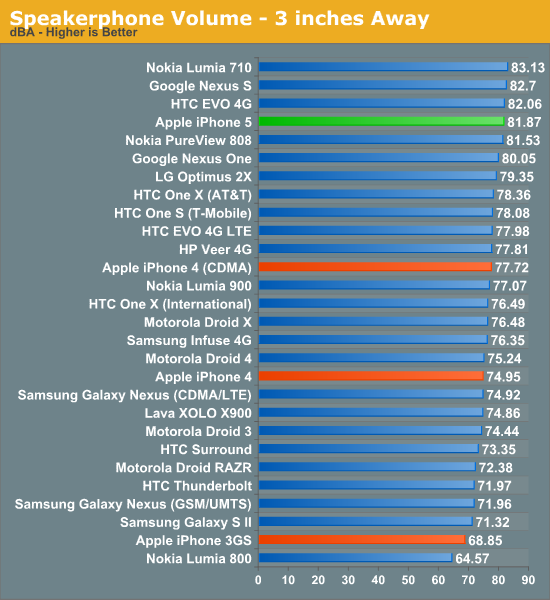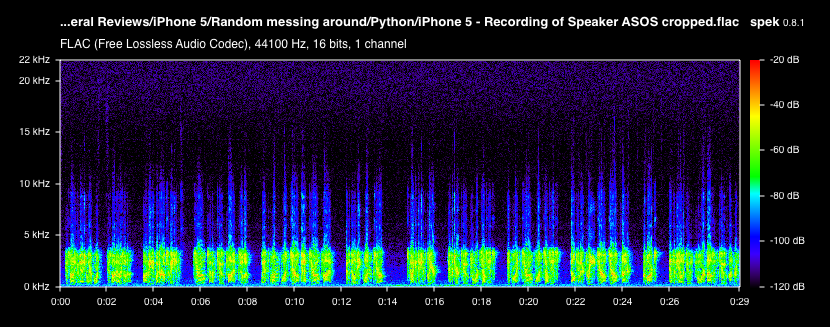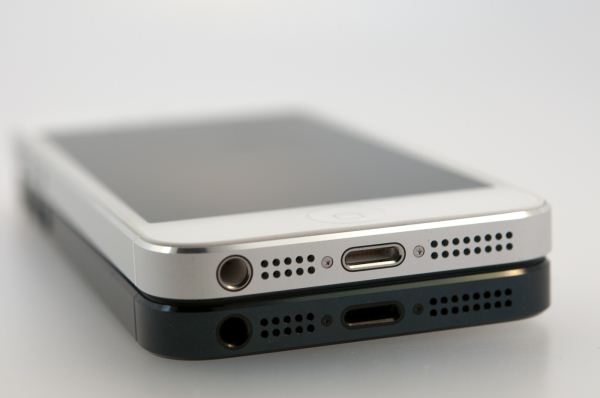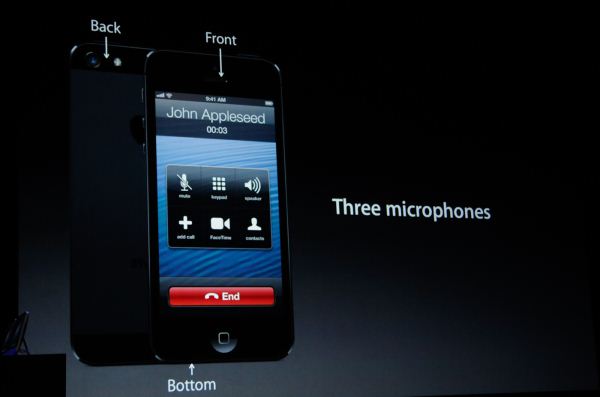The iPhone 5 Review
by Anand Lal Shimpi, Brian Klug & Vivek Gowri on October 16, 2012 11:33 AM EST- Posted in
- Smartphones
- Apple
- Mobile
- iPhone 5
Speakerphone and Noise Suppression
Section by Brian Klug
When Apple changed up the dock connector with the smaller Lightning port, it afforded a chance to also redesign the speakerphone at the bottom of the iPhone 5. Between the iPhone 4 and 4S we saw minimal changes, and performance was acceptable if a bit on the quiet side. With the iPhone 5 Apple advertised a big gain in audio quality with both changes to the speaker and a 5 magnet transducer design.
We normally test speakerphones by calling the local ASOS test number at max volume in front of an Extech sound data logger sampling continually and then averaging over one readout of the weather report. This gives a good feel for the overall loudness of the speakerphone on a call, but doesn’t tell us anything about quality unless you’re standing in front of it. In this case, the iPhone 5 is quite loud and comes in near the top of our scale at 81.8 dBA. It isn’t chart topping but a definite improvement over the relatively quiet 4/4S speakerphone design.

I decided to do something different though after getting a lot of questions and emails asking for a better quality comparison between the iPhone 5 speaker and its predecessor. People are interested in using their smartphones to listen to music when speakers or a dock aren’t available, and I thought this worth investigating. To get to the bottom of this I used my Blue Yeti USB microphone and arm which I use for podcasting to record the speakerphone output at 90 percent volume on the iPhone 4S and iPhone 5.
I started with the test call, which sounds surprisingly different between the iPhone 4S and iPhone 5. The 4S saturates and has obvious distortion even at 90 percent volume. This is quite noticeable in the recording. It then occurred to me that because I’m calling over AT&T (narrowband AMR) and to a PSTN (public switched telephone network) that the call would be limited to 4 kHz thanks to filters along the route, therefore anything above 4 kHz is undesirable. I took a spectral analysis (which shows power spectral density), and instantly it became obvious just how much energy there is on the 4S above the 4kHz limit from overmodulation or saturation/clipping on that speakerphone design. Meanwhile the iPhone 5 has much less energy over that 4 kHz maximum for a PSTN call.
I did the same for two songs recorded start to finish, and the differences are quite noticeable even in my rather quick and dirty recording plus spectogram comparison. I cropped the two recordings of the songs quite a bit and stuck them on soundcloud.

My overall impressions with the iPhone 5 speakerphone is that it has much less of a tendency to clip and saturate than the 4S, all while being noticeably louder. It’s still a smartphone speakerphone but to my ears the difference is pretty dramatic.
Noise Suppression
We’ve known for a while now that Apple changed up the slot for noise cancellation in the iPhone 5. The story goes something like this — Audience was a discrete chip on the iPhone 4, an IP block on the A5 SoC for iPhone 4S, and also an IP block onboard the A6 SoC for iPhone 5. The difference is that with iPhone 5 Audience isn’t enabled, and the company knows this because final characterization with both the final industrial design, microphones, and performance was never performed. Audience claims it met all of its deliverables and targets with the new IP block it built and gave Apple for inclusion on the A6. There’s obviously a lot of speculation about exactly why Apple chose to go with its own soultion versus Audience.
We’ve seen Audience earSmart noise suppression processors in a number of smartphones to date, and carriers often have their own specification for noise suppression to get certified. In addition, with wideband voice (AMR-WB in the case of the iPhone 5) noise suppression is even more important, to say nothing of how big of a topic this is with voice recognition based features like Siri. While we’re on the subject of AMR-WB, this feature is enabled on the iPhone 5 but I’m unable to test it on any of the carriers in the USA at the moment.
Anyhow, the iPhone 5 uses an Apple-specific solution with three total microphones all around the device. One primary microphone at the bottom of the device where you’d expect the primary microphone to reside, a secondary microphone between the LED flash and camera module, and a third right next to the earpiece for use with earpiece active noise cancelation. Apple’s solution is a beamformer (Apple said so in the keynote) and from what I can tell thus works entirely in the time domain. I’ve spent a lot of time playing around with the iPhone 5 trying to characterize its noise rejection, and the system appears to have a number of modes it will kick into after a 5–10 second adaptation time.
Earpiece noise rejection is something I talked about on the podcast right after the iPhone 5 hands on, and is one of those modes that the iPhone 5 will kick into if you’re in a loud environment. It isn’t active all the time, but when it does transition into working it provides a noticeable suppression of ambient noise and the same kind of pressure I’ve felt with other active noise canceling closed ear headphones. The improvement isn’t overwhelming, but it’s a sensation and feature I haven’t experienced on any other smartphones to date.
The rest of the noise suppression story is really one of testing. To test, I ran our normal test suite which consists of me ramping ambient music to 94 dBA while speaking into the device under test and recording the other side of the call. I’ve gotten ahold of the industry standard babble and distractor tracks used by carriers for testing noise suppression and will move to those in the future, for now though the test track I currently play is something I understand pretty well.
The comparison here is between the iPhone 4S and iPhone 5 to see just how ambient noise suppression has changed with this change in solution. The difference in technique is pretty apparent, and again indicates to me that the iPhone 5 is working in the time domain. You can see visible cut in and cut out on the waveform. The Audience solution has some hiss that develops at the absolute highest background noise volume on the 4S, but it also does an excellent job suppressing noise. The Apple solution doesn’t have this hiss, but passes both background noise and vocals from the music passed through the call at maximum volume. I hate to call this a regression, but the difference in technique means that there’s audible background noise that gets passed on while I’m talking on the iPhone 5. I think for normal callers the difference won’t be readily apparent, but with close inspection it is dramatic.













276 Comments
View All Comments
TrackSmart - Wednesday, October 17, 2012 - link
Shouldn't the battery life on the Verizon Galaxy SIII with LTE be higher than shown? That result bunches up with the 3G scores rather than the LTE scores. I wonder if the "LTE" listing is a typo.It's also a bit surprising how much of a difference the connection speed makes (3G vs 4G LTE) for the battery life tests. Are you guys really testing differences in power efficiency under typical use? Or have you, inadvertently, created a strange test of air interface throughput/watt - which would vary based on signal strength and network speed, but not based on the main device power draw under typical browsing (i.e. screen + intermittent CPU usage spikes).
I would have guessed that that screen power draw would be the largest cause for differences between handsets, not the air interfaces on the new devices, now that LTE is no longer a power hog.
phillyry - Sunday, October 21, 2012 - link
If it's anything like the Telus GS3 up here in Canada than it's not likely a typo. My brother has it and it tanks so bad on LTE that he keeps it turned off. Same thing with NFC btw. Two major selling features of the GS3 that went down the tubes in reality.Skidmarks - Wednesday, October 17, 2012 - link
I've got to hand it to Apple, if nothing else they sure know to market their rubbish.Freakie - Wednesday, October 17, 2012 - link
I haven't seen the 5 in person, but every time I see a picture of the front of it, I swear its design echos Samsung devices quite a bit. If any light hits it directly then it looks off-black, at least in the pictures, to the point of looking like Samsung's Pebble Blue color back when it was a bit darker (Samsung Impression).They got rid of the band around the phone and just have a slanted surface which when looking at pictures taken 8 inches away from the phone, has it's sharp "edges" that it slants to become one smooth transition. Reminds me a lot of the GSII's front.
Now I'm not a fan of any design litigations going either way, but I've never seen a Samsung device echo the looks of Apple's devices quite as much as the iPhone 5 echos a number of Samsung's design flairs that they've been using for a while.
Just my two cents xP
kmmatney - Wednesday, October 17, 2012 - link
Are you kidding me. Look at how much the original; Samsung Galaxy copies the iPhone 3G. Same with the Galaxy SII.See for yourself
3G versus SGI
https://encrypted-tbn1.gstatic.com/images?q=tbn:AN...
and 4S versus SGII
http://www.gizmowatch.com/entry/comparing-mights-i...
medi01 - Wednesday, October 17, 2012 - link
Wow, SGII and 4S have the same screen ratio, you shameless iScum...Freakie - Wednesday, October 17, 2012 - link
Oh I never said that Samsung hasn't produced a phone similar to an iPhone, though your second picture is pretty ridiculous (that's the SGI not SGII) which came out several months before the 4. Not only that but the picture its self is most definitely shot/edited in a way to make them as similar as possible.My complaint is just Apple doing something very different than normal, and echoing someone else for a change. Usually they seem to go for something different than the rest and the iPhone 5 most definitely does not come anywhere near that.
steven75 - Wednesday, October 17, 2012 - link
This is probably the most silly comment I've read among any iPhone reviews. iPhones have always been similar overall since the revolution if 2007 and now you are seriously making the claim this looks more like a Samsung device?/smh
MNSoils - Wednesday, October 17, 2012 - link
Apple has an interesting story here and your group did a wonderful job telling it.On the 2 graph of the "Increased Dynamic Range" page, the idle power for the Tegra 3 SOC after finishing the Kraken benchmark seems awfully high for just the companion core. Does more time have to elapse before Android reverts to the companion core? Is the companion core not that power efficient (power-gated, etc.)? Does Android revert to the companion core?
colonelclaw - Wednesday, October 17, 2012 - link
Thanks for a terrific article. It's just a shame that about 75% of the comments will be by people who either love the device or hate it, and nothing in this carefully researched and written appraisal will make them change their minds either way.How did we get to this? Actually, don't answer, that would turn into an irrelevant pissing match too.